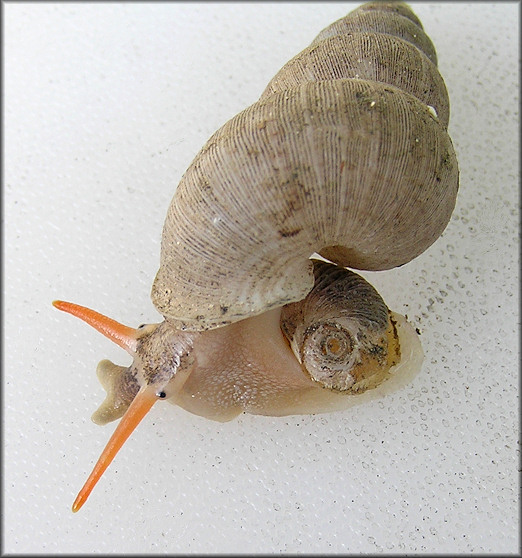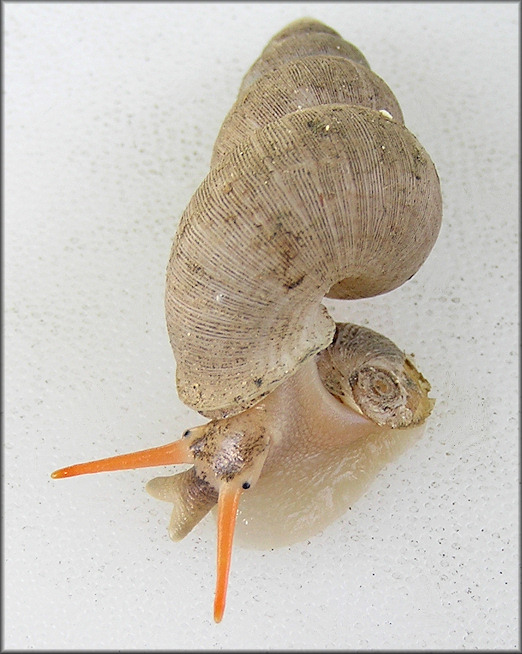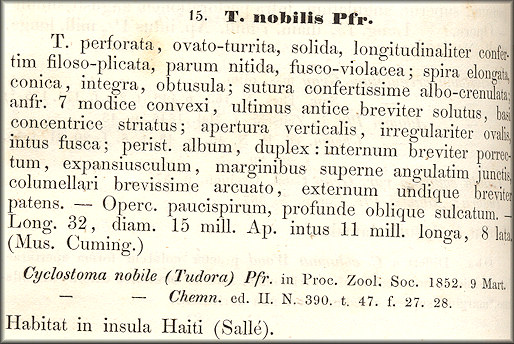|
At first reading, these two citations appear to index publications
antedating the description above them, but the following evidence
indicates that this was not the case at all.
Although the paper Pfeiffer read was published in the "Proceedings of
the Zoological Society 1852" (Zoological Society of London 1863: 44,
76, 149)
[see Page Two], later bibliographic research placed the actual date for the
publication of the paper at 27 June, 1854 (Pilsbry, 1933: 127; Duncan, 1937),
which clearly is after the Monographia Pneumopomorum description,
i.e, L. Pfeiffer (1852) vs. L. Pfeiffer (1854a).
The other item in this chresonymy refers to the second, or "Küster"
edition of the Conchylien-Cabinet, a monograph initiated by
Martini and Chemnitz, who were the principal contributors of twelve
volumes appearing from 1769 to 1829. The second edition, initially under
the editorship of H. C. Küster (1807-1876), was intended to account systematically and
illustrate every known mollusk. The work was released in 584 issues (Lieferungen)
with taxonomic groups published intermittently and in almost haphazard
sequence, comprised over 100 volumes, treated nearly 4400 molluscan
species, and ran from 1837 to 1920. To say that the work is a
bibliographers nightmare is hardly doing justice to this byzantine but
indispensable work. Fortunately for malacologists, Francisco Welter-Schultes
(1999) has provided an extensive collation of this work. This allows
proper dating of the treatment of H. strumosa in the
Conchylien-Cabinet, and it was in 1854 (Welter-Schultes, 1999: 168),
i.e. Pfeiffer (1854b)! Since Pfeiffer was able to cite pagination and
the plate/figures, it appears that he somehow had access to the Küster
production, which had reached galley proof or some stage approximating
that level of prepublication format. Such occurrences may not have been
unusual in the expansive and convoluted production as the second edition
of the Conchylien-Cabinet. Thus the proper, chronologically the
first, attribution of this species is Tudora nobilis L. Pfeiffer,
1852; Pfeiffer, 1854a and Pfeiffer 1853-1854 [1854b so to speak] contain
only minor revisions of that available name.
Above I wrote "The name Cyclostoma nobile .... came to the
attention of the scientific community on March 9, 1852" Well, that is a
bit misleading. There is an earlier published usage of this binomen. The
above unravelling of the anachronistic chresonymy in Pfeiffer (1852:
252) bears on Cyclostoma nobile Potiez and Michaud, 1838: 233.
These authors
cited "Cycl[ostoma] nobile, Fer. coll." as a "?" synonym
of Cycl[ostoma] blanchetianum Moricand, 1826, which species is
presently placed in the genus Aperostoma Troschel, 1847. This
genus is presently placed in the Cyclophoroidea: Megalomastomidae, as
opposed to the Cyclophoroidea: Annulariidae, the modern placement of the
Pfeiffer species (Watters, 2006: 375).
Potiez and Michaud likely saw a specimen
label or correspondence attributed to André Étienne Justin Pascal
Joseph François d’Audebard, Baron de Férussac
(1786-1836), who seems to
have never formally published this binomen.
Aperostoma
blanchetianum (Moricand, 1826)
is treated by Simone (2006, 43; figs.
42A, B). Interestingly, both Simone and the monographers Torre, Bartsch,
and Morrison (1942: 244, 245) overlooked the synonymy with
Cyclostoma
nobile Potiez and Michaud, 1838.
Under these
unusual bibliographic circumstances, one should question whether
Cyclostoma nobile Potiez and Michaud, 1838 is an available name,
specifically for the purpose of [senior] homonymy. The relevant
provision in the Code (ICZN, 1999) is Article 11.6 Publication as
a Synonym, which reads: "[If] A name which when first published in an
available work was treated as a junior synonym of a name then used as
valid is not thereby made available." One relevant exception immediately
follows (11.6.1): "However, if such a name published as a junior synonym
had been treated before 1961 as an available name and either adopted as
the name of a taxon or treated as a senior homonym, it is made available
thereby but dates from its first publication as a synonym." Pilsbry
(1933: 127) wrote of our topical species: "Not Cyclostoma nobile Fer.,
Potiez et Michaud, 1838, Galerie Moll. Mus. Douai, vol. 1, p. 233."
Pilsbry's treatment of
Cyclostoma nobile
Potiez and Michaud, 1838
meets the
ICZN criterion to make it an available name, albeit a consensus synonym
of Cycl[ostoma] blanchetianum Moricand, 1826.
With Cyclostoma
nobile Potiez and
Michaud, 1838
an available name under the Code, any usage of
Cyclostoma
nobile by Pfeiffer (or any other author) after 1838 would fall into
primary junior homonymy under the provisions of the Code and thus
be unavailable. Before the anachronistic chresonymy in Pfeiffer (1853)
was unscrambled, this appeared to be a serious issue, but Pfeiffer's
usages of this binomen (L. Pfeiffer, 1854a, 1854b) were not
nomenclatorial acts. As Tom Watters put it (in litt., 2 October,
2010), this issue is "moot." The mootness became even more obvious when
I looked harder at the bibliography and chresonymy in Watters (2006:
113-114; 275), who had already done most of the literature review I
thought I was pioneering.
Moot it is, but this exercise in nomenclatorial forensics helps reveal
the complexities of taxonomic nomenclature and the value of
bibliographic collations such as that of
Duncan (1937 [with the work of Waterhouse
and of Peavot therein]) and of Welter-Schultes (1999) in getting the
nomenclature right. The application of such bibliographic insights
allows rectification of long-standing errors in the literature, e.g.,
the case of Helix strumosa (see:
Plagioptycha strumosa (Reeve, 1852) and the legions of
misattributions uncovered by Petit (2009).
On the taxonomic side of the story, Tudora nobilis L. Pfeiffer,
1852 was transferred to Parachondria Dall, 1905 by
Twentieth Century authors. The species is the type of
Parachondria (Clydonopoma)
Pilsbry, 1933: 127 not of Bartsch, 1946
as indicated by Watters (2006: 375)]
by original designation.
Despite its initial generic association, the subgenus Clydonopoma was treated as a synonym of Chondropomium Henderson and
Bartsch, 1921: 60 (Annulariidae: Tudorinae) by Watters (2006: 62;
Appendix A2), who maintained Parachondria Dall, 1905 (Annulariidae:
Chondropomatinae) as a valid genus (Watters, 2006: 41; Appendix A2). In
the intriguing case of Tudora nobilis L. Pfeiffer, 1852,
byzantine machinations are certainly not limited to the nomenclatorial!
I
wish to thank Richard I. Johnson and Dr. G. Thomas Watters for providing
lively discussion and relevant literature.
*Now called the
"Natural History Museum" or the "Natural History Museum, London." It was
formerly dubbed "British Museum (Natural History); BM(NH)."
Literature cited:
Bartsch, P., 1946. The operculate land mollusks of the family
Annulariidae of the Island of Hispaniola and the Bahama Archipelago.
Bulletin of the United States National Museum 192: 1-364 + plates
1-38. (reference).
Dance, S. P., 1986.
A history of shell collecting. E. J. Brill - Dr. W. Backhuys,
Leiden, 1986. pp. 1-265 + xv + 32 pls. + frontispiece.
Duncan, F. M., 1937. On the dates of
publication of the Society's "Proceedings." 1859-1926. With an appendix
containing the dates of publication of "Proceedings" 1830-1858, compiled
by the late F.H. Waterhouse, and of the "Transactions" 1833-1869, by the
late Henry Peavot, originally published in the P.Z.S. 1893, 1913.
Proceedings of the Zoological Society of London 107: 71-84. Not
seen.
Henderson, J. B. and P. Bartsch, 1921. The Classification of American operculate land mollusks of the family Annulariidae. Proceedings of
the United States National Museum 58 (2327): 49-82. 8 July.
(reference
- see p. 60).
ICZN (International
Commission for Zoological Nomenclature), 1999. International Code of
zoological nomenclature fourth edition. International Trust for
Zoological Nomenclature, London. pp. 1-306 + i-xxix.
Petit, R. E., 2009. George
Brettingham Sowerby, I, II, & III: their conchological publications and
molluscan taxa. Zootaxa 2189: (1)-218. 6 Aug.
Pfeiffer, L., 1852. Monographia Pneumopomorum viventium. sistens
descriptiones systematicas et criticas omnium hujus ordinis generum et
specierum hodie cognitarum, accedente fossilum enumeratione.
Cassellis, Paris, London. xviii + 1-439. After July. (reference
- search for "nobile.").
Pfeiffer, L., "1852" [1854a, 27 June; see Duncan]. Descriptions of twenty-four species of
land shells collected by M. Sallé on the island of Santo Domingo, from
Mr. Cuming's collection. Proceedings of the Zoological Society of
London 1852 20: 138-144 + plate 13. "9 March, 1852" [27 June, 1854]. Not
seen; but see Zoological Society of London, 1863.
Pfeiffer, L., "1853" [1853-1854]. Cyclostomaceen. Zweite Abtheilung.
Systematisches Conchylien-Cabinet von Martini und Chemnitz 1 (19)
[(2)]: 229-400, plates 31-50. [1854b in the case of the topical taxon].
Pilsbry, H. A., 1933. Santo Domingo land mollusks collected by Samuel C.
Pease, 1932, and by A. A. Olsson, 1916. Proceedings of the Academy of
Natural Sciences 85: 121-162, figs 1-2, plates 6-11.
Potiez, V. L. V. and A. L. G. Michaud, 1838. Galerie des mollusques, ou
catalogue méthodique descriptif et raisonné des mollusques et coquilles
du Muséum de Douai. Tome 1. Baillière, Paris. [i]-xxxvi + 1-307.
(reference
- see p. 233).
Sherborn, C.
D., 1940. Where is the _____ collection? An account of the various
natural history collections which have come under the notice of the
compiler Charles Davies Sherborn D. Sc. Oxon. between 1880 and 1939.
University Press, Cambridge (U. K.). pp [1-5] 7- [149], [verso pp. 6-148
unpaginated and blank].
Simone, L. R. L., 2006. Land and
Freshwater Molluscs of Brazil. EGB, Fundação de Amaparo à Pesquisa
do Estado de São Paulo, São Paulo. 390 pp.
Torre, C. de la, P. Bartsch, and J. P. E. Morrison, 1942. The cyclophorid
operculated land mollusks of America. United States National Museum
Bulletin 181: iv + 1-306 + 42 plates. 9 June. (reference
- see pp. 244-245).
Watters, G.T., 2006.
The Caribbean Land Snail Family Annulariidae: A revision of the higher
taxa and a catalog of the species. Backhuys, Leiden [viii] + 1-557 +
1 pl. + 8 pp. maps + 488 pp., 10 figs., 56 maps.
Welter-Schultes, F. W., 1999.
Systematisches Conchylien-Cabinet von Martini und Chemnitz
(1837-1920), bibliography of the volumes in Göttingen. Archives of
Natural History 26(2): 157-203.
Zoological Society of London, 1863. Proceedings of the Zoological
Society of London. Index. 1848-1860. Zoological Society of London,
London. [i-iii] + 1-304.
(reference - see pp. 44,
76, 149). |


